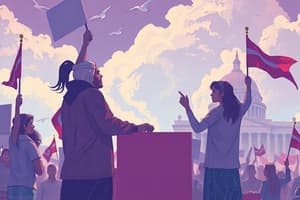Podcast
Questions and Answers
What should the stem of a question convey?
What should the stem of a question convey?
- A vague problem to provoke thought.
- A definite problem without irrelevant material.m (correct)
- An irrelevant background situation.
- A negatively stated question to confuse students.
Which of the following is a guideline for constructing options in a multiple-choice question?
Which of the following is a guideline for constructing options in a multiple-choice question?
- Include distractors that are too obvious.
- Provide an 'all of the above' option.
- Ensure options are mutually exclusive and plausible. (correct)
- Use complex language to test vocabulary.
What is crucial about the correct answer in a multiple-choice question?
What is crucial about the correct answer in a multiple-choice question?
- It should represent common misconceptions.
- It must be the only correct answer. (correct)
- It can be ambiguous to challenge students.
- It should be the least plausible option.
When should a question stem be stated negatively?
When should a question stem be stated negatively?
What should be avoided in the construction of distractors?
What should be avoided in the construction of distractors?
Which amendment specifically granted women the right to vote?
Which amendment specifically granted women the right to vote?
What is the main purpose of political parties in the U.S.?
What is the main purpose of political parties in the U.S.?
Which voting behavior model involves predicting how a candidate will perform in the future?
Which voting behavior model involves predicting how a candidate will perform in the future?
What barrier is commonly cited as a structural obstacle for third parties in elections?
What barrier is commonly cited as a structural obstacle for third parties in elections?
Which factor is NOT a predictor of voter turnout?
Which factor is NOT a predictor of voter turnout?
Which of the following is a function of interest groups?
Which of the following is a function of interest groups?
Which constitutional amendment abolished poll taxes?
Which constitutional amendment abolished poll taxes?
What is a consequence of the Citizens United decision in campaign finance?
What is a consequence of the Citizens United decision in campaign finance?
Which voting behavior is primarily influenced by a voter's belief that their participation can impact political outcomes?
Which voting behavior is primarily influenced by a voter's belief that their participation can impact political outcomes?
What type of campaigns focus more on individual candidates rather than party affiliation?
What type of campaigns focus more on individual candidates rather than party affiliation?
Flashcards are hidden until you start studying
Study Notes
Expansion of Voting Rights
- 15th Amendment: Granted voting rights to African American men.
- 17th Amendment: Allowed for the direct election of senators.
- 19th Amendment: Granted voting rights to all women.
- 24th Amendment: Eliminated the poll tax as a voting requirement.
- 26th Amendment: Lowered the voting age to 18.
Political Models of Voting Behavior
- Rational-choice voting: Individuals vote based on their perceived self-interest.
- Retrospective voting: Voters decide whether to re-elect a party or candidate based on their recent performance.
- Prospective voting: Voters choose a party or candidate based on their predicted future performance.
- Party-line voting: Supporting a party by voting for all candidates within that party.
Predictors of Turnout
- Political efficacy: Belief that one's vote can influence political outcomes.
- Demographics of most likely voters: Voters with higher education, income, are middle-aged or older, White and/or religious are more likely to vote.
Factors Influencing Voter Choice
- Party identification and ideology: Voters tend to favor candidates who align with their party platform and ideology.
- Candidate characteristics: Voters consider the candidates' experience, personality, and stances on issues.
- Contemporary political issues: Voters are influenced by current events and issues that are important to them.
- Religious beliefs, gender, race, and ethnicity: Social identities can influence voter choices.
Weakening & Changing Political Parties
- Candidate-centered campaigns: Voters increasingly focus on individual candidates over party affiliation.
- Regional realignments: Shifting patterns of party loyalty, like the South transitioning from Democratic to Republican.
- Campaign finance law: Citizens United decision has increased political spending, allowing candidates to be less reliant on party funds.
- Rise of the primary system: Citizens now have a greater say in choosing their party's nominees.
- Social media & voter management data: New strategies for targeting voters effectively.
Purpose & Functions of Political Parties
- Primary purpose: Gaining power and winning elections.
- Functions:
- Mobilizing and educating voters.
- Establishing party platforms.
- Recruiting candidates.
- Managing campaigns, fundraising, and media strategy.
- Organizing committees and party leadership within Congress.
Third Parties
- Structural barrier: Winner-take-all electoral systems in Congress make it difficult for third parties to gain representation.
- Informal barrier: Major parties often incorporate popular third-party policy ideas into their platforms.
Purpose of Interest Groups
- Influencing public policy on specific issues.
Functions of Interest Groups
- Educating voters and officeholders.
- Providing information to lawmakers.
- Drafting legislation.
- Mobilizing members to "get out the vote" (GOTV).
- Lobbying Congress, often forming "iron triangles" with congressional committees and governmental agencies.
Interest Group Influence is Impacted by
- Inequality of political and economic resources: Some interest groups have greater resources and influence.
- Unequal access to decision-makers: Powerful interest groups may have easier access to lawmakers.
- Free rider problem: Individuals may benefit from a group's efforts without participating or contributing.
Structural Barriers to Voting
- State voter registration laws: Can make it difficult for some to register to vote.
- Procedures on how, when, and where to vote: Varying state laws can create barriers to casting a ballot.
- State voter ID laws: Can disproportionately impact certain groups, like minorities.
Studying That Suits You
Use AI to generate personalized quizzes and flashcards to suit your learning preferences.




